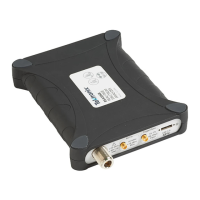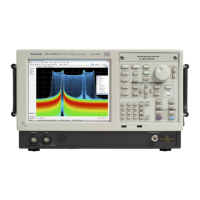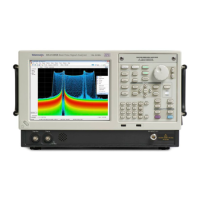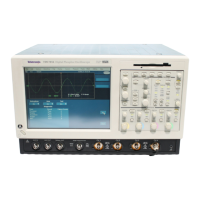Performance ver
ification
1190 MHz half-IF.
5. Set the signal generator to 595 MHz.
6. Set the generator amplitude to –23 dBm.
7. Set the tunable band pass filter (K&L 5BT-375/750-5-N/N) near 595 MHz.
8. Adjust the tunable filter for maximum power on the power meter.
9. Adjust the signal generator output for -30 dBm at the power meter. This is also the amplitude at the input of the RSA306.
The generator amplitude will be close to -23 dBm.
10. Set the RSA306 to the center frequency shown in the first column of the 1190 MHz half-IF table. (See Table 21
on page 46.)
11. Measure and record the Half-IF spur amplitude.
12. Calculate and record the H alf-IF spur amplitude in dBc ( Half-IF amplitude (dBm) +30).
13. Repeat steps 10 through 12 for each c enter frequency listed in the table.
14. Record results in the Test record.
Table 23: 1190 MHz half-IF spurious: RSA306 center frequencies
Center frequenc y, MHz
(RSA306)
Half-IF spur amplitude,
dBm
Half-IF spur amplitude,
dBc
1
Specification, dBc
(relative to –30 dBm
input)
1860 MHz < –50 dBc
2430 MHz < –50 dBc
2710 MHz < –50 dBc
3710 MHz < –50 dBc
4600 MHz < –50 dBc
5000 MHz < –50 dBc
6000 MHz < –50 dBc
1
Half-IF spur amplitude + 30.
2440
MHz half-IF.
15. Set the signal generator output to Off.
16. Replace the tunable band pass filter with the K&L 5BT-750/1500-5-N/N tunable filter.
17. Set the tunable band pass filter near 1220 MHz.
18. Set the signal generator output to On.
19. Set the signal generator to 1220 MHz.
20. Set the generator amplitude to -23 dBm .
21. Adjust the tunable filter for maximum power on the power meter.
22. Adjust the s ignal generator output for -30 dBm at the power meter. This is also the amplitude at the input of the RSA306.
The generator amplitude will be close to -23 dBm.
RSA306 Specifications and Performance Verification 50
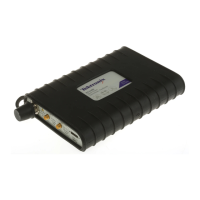
